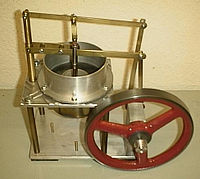
Photo from wikipedia
Abstract In this study, a numerical and experimental investigation was carried out to research the effect of three types of working fluids (i.e., helium, nitrogen and argon) on the performance… Click to show full abstract
Abstract In this study, a numerical and experimental investigation was carried out to research the effect of three types of working fluids (i.e., helium, nitrogen and argon) on the performance of a thermoacoustic Stirling engine. To predict and analyze thermoacoustic conversion capacity of the engine, a wide range of critical parameters (e.g. onset temperature, working frequency and pressure oscillations) were selected as analysis parameters. According to the results, a relatively optimum value of mean pressure (0.7–1.0 MPa) appears when the thermoacoustic engine is filled with helium. Compared to other working fluids (i.e, nitrogen and argon), the engine could work (onset temperature below 500 °C) in a relatively high mean pressure range (0.4–2.6 MPa) when using helium. Furthermore, working frequency of helium was found to be nearly three times that of the other two gases regardless of operating conditions. Moreover, when using nitrogen and argon as working gases, the pressure amplitude of thermoacoustic engine was significant under the condition of the same mean pressure. The findings in this study are helpful to improve the practicability of thermoacoustic engine.
Journal Title: Energy
Year Published: 2019
Link to full text (if available)
Share on Social Media: Sign Up to like & get
recommendations!